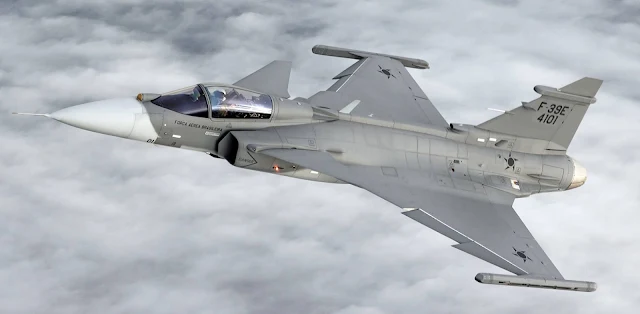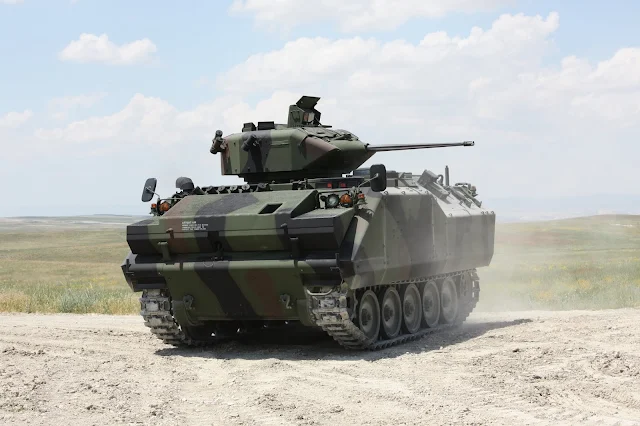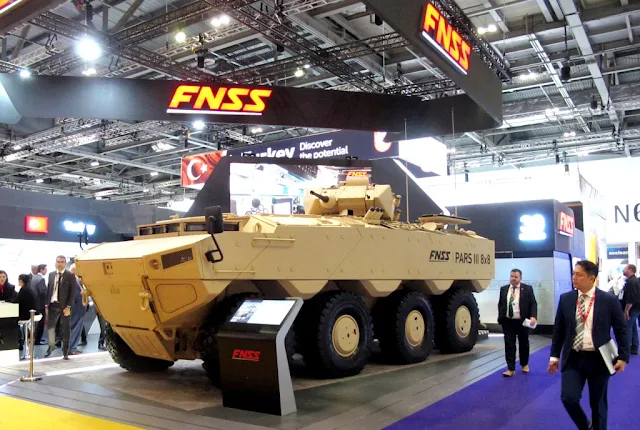The Philippine Air Force, through the Department of National Defense, is still about to decide which Muti-role Fighter Jet candidates and the aerospace companies took part may get the contract for what may consider the most expensive undertaking that the Armed Forces of the Philippines has taken to date.
And speaking of expensive, the problems surrounding the source of funds and budgetary allotments give rise to this financing scheme that an aerospace industry hope that the end-user may get enticed and consider the deal altogether.
AS FIRST REPORTED
 |
Swedish Air Force's JAS-39 Gripen, the country's mainstay fighter produced by SAAB, a Swedish company.
Image Source. |
A source coming from a reputable European defense website highlighted the ongoing limbo surrounding the Multi-role Fighter Jet Acquisition Project of the Philippine Air Force, as the leadership is still about to choose between SAAB Aerospace's JAS-39 Gripen C/D variant and Lockheed Martin's F-16 Block 70/72 variant, each with their key marketing points that are enticing enough for the key decision makers to consider.
However, what makes this acquisition program taking so long to materialize points to the availability of funds, specifically the source intended to provide financial resources with the need to fund the project with a contract price of around Php 61 Billion Pesos, with current exchange rates and inflationary elements making these things more problematic for the movement of progress on this acquisition program.
This is not to mention that both Lockheed Martin and SAAB are pushing their key marketing points in pursuit of bagging the contract and eventually expanding their reach within the Philippine defense market, with the former surely having the support from the United States government, and the latter recently received export approval from the Swedish government that allowed them to sell jets to the Philippines.
Speaking of the latter, the same reputable European defense website we linked has also provided information related to SAAB monitoring the actions of their competitor for this project, whereby they presented this enticing financial arrangement, especially that they saw the pace of this project being at the standstill given the inadequate financial ability for it to push through.
This financial arrangement is more known as the lease option, whereby the lessor, being the owner of the goods, provides such goods to the lessee, in exchange for a monthly payment made by the latter for the value of the goods used, usually under a contract whereby there are specifications regarding the terms of payment, and the specified time for the lessee to pay the lessor until the completion of the terms.
THIS SCHEME IS NOT NEW
 |
The Czech Air Force actually engages in leasing JAS-39 Gripen from Sweden, with the terms expire in 2027.
Image Source. |
While the Philippine Air Force is really determined to buy a squadron of Multi-role Fighter Jets using its allotted budget to ensure that it has the full ownership of the jets in terms of operations and maintenance, the lease option presented by Swedish defense company SAAB Aerospace for this acquisition project is not new, as several air forces in Europe availed this scheme that provides less a burden for them from the budgetary point of view.
One notable example is the country of Czech Republic (or Czechia, for some readers), whereby they have leased JAS-39 Gripen from Sweden, of which these jets are currently in service since 2005 with the renewal of the lease took place in May 2014, approximately nine (9) years since this article published and the terms of the lease extended for thirteen (13) years until the year 2027.
The new agreement forged from that time between both parties includes hardware modification and software upgrades for the leased JAS-39 Gripen that Czech Air Force has in its inventory, which were apparently done by the lessor intended to improve the capabilities of the aircraft and meeting the requirements that the Czech Air Force has during that time.
Last year, the Czech government was considering a replacement for the leased JAS-39 Gripen they currently have until the term expires in 2027, although these leased aircraft still have the option of extension for at least two years until 2029, whereby it will be at the discretion of the government to do so, with the likelihood of an extension gets slim as the government is determined to secure a newer type of fighter aircraft like the F-35 Lightning II, especially given the current security situation in the Eastern Europe and the current Russian-Ukrainian conflict.
Another example of a country that leased JAS-39 Gripen Fighter Jets from Sweden is the country of Hungary, which, like the Czech Republic, is a Central European country that is a member of both the European Union and the North Atlantic Treaty Organization or NATO, whereby Sweden leased their JAS-39 Gripen to Hungary, in which, like the Czech, also comes with 14 units (12 single-seater and 2 two-seater aircraft).
Just like the Czech Republic before them, the Hungarian Air Force benefited much from the lease as their JAS-39 Gripen in 2017 have upgraded with the MS20 variant, basically the same upgrade offer made by SAAB for the Philippine Air Force for the current Multirole Fighter Acquisition Project aside from the lease option scheme being pushed to decrease the financial burden on the side of the end-user.
Given the SAAB's offer for Multirole Fighter Jet Acquisition Project, it might not be surprising if their deal also comes with the same number of units, with 12 single-seater units offered (as it is with the number of units that are specify under the Acquisition Project), plus two double-seater units, totalling to 14 units all-in-all, with the lease option now on the table, enticing the Philippine Air Force to consider it.
Speaking of lease options, let's talk about its advantages and disadvantages.
ADVANTAGES
One primary advantage we can point out right away from this leasing option offer by SAAB regarding their marketing of the JAS-39 Gripen Block C/D to the Philippine Air Force is that it would lessen the financial burden surrounding the deal, on what should be difficult to pull on an outright purchase of the multi-role fighter jets that the leadership is currently pursuing, with the project itself being in the slow pace.
This is in fact the primary aim of presenting a lease option deal, as this option provides the end-user such as the Philippine Air Force the time to lobbying up the budget it requires for the outright purchase of the fighter jets on a later date, albeit in a much affordable manner as compared to the current procurement pace that requires securing the availability of funds, on an expanded time period of ten to thirteen years lease period like Czechia and Hungary as opposed to the Multi-Year Contracting Authority or MYCA, with the remaining balance paid on the final batch delivery of the jets in three to five years time.
Further detailing the budgeting that comes with a lease option, the finance unit within the Defense Department can manage and monitor the release of the budget for the payment of the lease option, as the terms specified in the contract may come with a fixed price for the payment, chargable against the rent expense of the department's budget or those of the Philippine Air Force's annual budget under any crafted General Appropriations Act in the later years, subject to usual Accounting Rules and Regulations (or any guidelines written in the Government Accounting Manual formulated by the Commission of Audit 2015).
Another advantage that may come with this arrangement is that the lessor like SAAB may be the one who looks for the maintenance and upgrades of the JAS-39 Gripen of the Philippine Air Force, in the same manner and benefit that countries who leased such jets like Czech Republic and Hungary do, with the latter upgraded theirs to the MS20 Block 20 upgrade.
One cannot help but see the operational situation involving the Philippine Air Force's FA-50PH Lead-In Fighter Trainers made by Korea Aerospace Industries, whereby there were only five (5) out of twelve (12) aircraft that are operational, as the others were apparently lack spare parts to operate, something that may not happen on a lease option shall this deal with the JAS-39 Gripen push through since SAAB and Sweden's FMV defense materiel administration calls the shots in terms of maintenance support.
DISADVANTAGES
 |
Brazil Air Force's Gripen E, the latest variant of the SAAB JAS-39 Gripen Family.
Image Source. |
While the lease option has its advantages, the offer made by SAAB, like anything else, also has its own disadvantages that the likes of the Philippine Air Force need to take some note, especially in weighing in the feasibility of this arrangement before deciding of getting all-in for choosing the JAS-39 Gripen Block C/D for the air branch's Multirole Fighter Jet Acquisition Project.
First to take note is the treatment of the JAS-39 Gripen on the government books, especially in the compliance of the 2015 Government Accounting Manual or GAM, whereby it treats as an expense rather than an asset, especially that this lease option siphons a portion of the Philippine Air Force's Maintenance and Other Operating Expenses or MOOE portion of its annual budget, particularly that specific item under Rent Expenses.
Since it is not on the government's accounting books as an asset, the JAS-39 Gripen C/D on the Philippine Air Force under lease are owned by SAAB with the support of the Swedish FMV Defense Materiel Administration, with provisions allotted to the lessee in terms of flight hours allowable for the jets to operate (with the measurements being the number of flight hours allotted per year), as these are the terms agreed by both sides on a lease contract, and the Philippine Air Force being a lessee, needs to comply the terms and conditions in that agreed lease.
Aside from the points provided above, another disadvantage to consider for a lease option is the political implications that may come from this deal, especially in the long run if the current landscape changes once again throughout the process of the lease, especially given that the Swedes wait for the former Duterte administration to leave office before giving a green light, approving the sale of the JAS-39 Gripen Block C/D to the Philippines.
Currently, this political implications for a lease option is not much of the concern, given the excellent relationship between Sweden and the Philippines, with the Swede ambassador recently visited the Department of National Defense, discussing the idea in relation to the sale of the JAS-39 Gripen Block C/D to the Philippine Air Force, depicting it as a sign of an ever-growing bilateral relations between the two countries.
Finally, another disadvantage that this lease option presented is this may limit the option for the Philippine Air Force in the future regarding any of its planned procurement of additional Multi-role Fighter Jets, as this may lock them in to the future purchase of JAS-39 Gripen E variant like the ones Brazil have (see image above) from the logistics point of view, whereby the idea of outright buying new fighter jets is back into the picture.
Since the production line of SAAB prefers JAS-39 Gripen Block E over the said variant that the Philippine Air Force is about to receive, this may limit them to only just the 14 offered units of the Multi-role Fighter Jets, relying fully to any upgrades that it may received from the date this article gets published to the year 2030, like what the SAAB recently announce in continuing the maintenance of Swedish Air Force JAS-39 Gripen Jets until that date.
WEIGHING IT IN AND SUMMARY
 |
| The iconic JAS-39 Gripen flying in the sunrise, with its silhouette seen against the gleaming sun in the background. |
After we weight on all the pointed advantages and disadvantages pointed above, we may say that upon checking every point taken about the lease option of the JAS-39 Gripen C/D for the Philippine Air Force, that such an arrangement may bring more benefit for the air military branch, especially to manage its budgetary requirements and maintaining it, although the leadership still has the discretion to buy the jets outright, or choose the Lockheed Martin's F-16s since it came with enticing deals of its own.
This is true for countries like Hungary and the Czech Republic, with their leases with SAAB gave them successful results, as they received upgrades on their multi-role jet platforms and other perks from this arrangement together with Swedish FMV Defense Materiel Administration, in exchange to their periodic payments for the lease, as this is economically more manageable than buying the jets with its face value, plus the constant maintenance it needed in-house by the mechanics of the end-user subject to the availability of funds for the procurement of spare parts.
While this bring benefit for the Philippine Air Force at the financial point of view, the plans of purchasing a Multi-role fighter jet outright may get its likely chance as the budgetary capacity gets greater, in an essence that such move, if materialize, provides time for the leadership along with the people in the Department of National Defense, to push for a higher financial requirement to buy another squadron of fighter jets, either it may be a Gripen E variant from the logistics point of view, or whether the F-16 Block 70/72 gets offered for an additional squadron separate from the JAS-39 Gripen, whatever it may be.
Despite the advantage that a lease option might bring for the Philippine Air Force, shall they consider this offer from SAAB after the Swedish government approves its sale to the country, all the decision making whether this option may get considered lies on the hand of the leadership within the Air Force and the Defense Department, as they have other considerations on the table that may determine the outcome of this big-ticket acquisition project that the Armed Forces of the Philippines has to-date.
Summing this up, the lease option of SAAB provides another option for the makers of the Multi-role Fighter Jet Acquisition Project to consider, as the offer made by the competitor actually comes with an extra number of jets plus training, especially that the production line of Lockheed Martin comes with order backlogs of 128 units for countries like Bahrain, Slovakia, Bulgaria, Taiwan, Morocco, and Jordan.
With Horizon 3 now at hand, perhaps it is finally the time now for the Philippine Air Force to choose the best candidate for the Multi-role Fighter Jet Acquisition Project and have the funding secured for this project to roll from production to delivery, complete with Philippine insignia.































.png)



